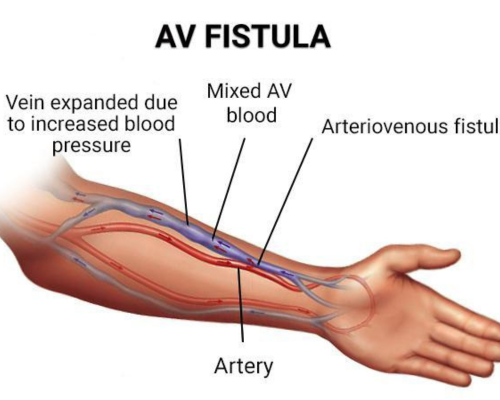AV Fistula
What is an AV Fistula?
An AV fistula (Arteriovenous Fistula) is a surgically created connection between an artery and a vein, typically in the arm. This connection is primarily used for hemodialysis, a treatment for patients with kidney failure. The AV fistula provides a reliable and durable access point for the dialysis process, allowing for the efficient removal and filtration of waste products from the blood when the kidneys are no longer functioning properly.
In an AV fistula, the artery carries blood to the vein, causing the vein to enlarge and thicken over time. This makes it easier for dialysis machines to access the blood, ensuring smoother and more effective treatment sessions.
How Does an AV Fistula Work?
The creation of an AV fistula is a carefully planned surgical procedure, performed under local anesthesia. The surgeon will connect an artery (usually in the arm) to a nearby vein, creating a direct passage for blood flow. This bypasses the smaller veins, which are not suitable for dialysis access.
Over time, as blood flows directly into the vein, it becomes enlarged and more suitable for the insertion of dialysis needles. Once the fistula matures (usually after 6-8 weeks), it can be used to access the bloodstream during dialysis treatments.
Why is an AV Fistula Important for Dialysis?
Dialysis patients require reliable and accessible blood flow to allow for the efficient filtration of waste products from the body. The AV fistula is considered the gold standard for dialysis access because:
- Longevity and Durability: AV fistulas last longer and have a lower risk of complications than other forms of dialysis access, such as AV grafts or central venous catheters.
- Lower Risk of Infection: Since the AV fistula uses the patient’s own veins, the risk of infection is significantly lower compared to other access methods.
- Better Blood Flow: The direct connection between the artery and vein allows for a high volume of blood flow, which is essential for effective dialysis.
- Reduced Complications: AV fistulas are less likely to form blood clots, blockages, or require repeated interventions compared to other dialysis access options.
Who Needs an AV Fistula?
An AV fistula is recommended for individuals with chronic kidney disease (CKD) or end-stage renal disease (ESRD) who require hemodialysis. Some common conditions that may lead to the need for an AV fistula include:
- Chronic kidney disease (CKD): When the kidneys are no longer able to filter waste products and excess fluids from the blood.
- End-stage renal disease (ESRD): A condition in which the kidneys fail to function properly, requiring dialysis to perform their work.
- Kidney failure: When kidneys lose their ability to filter waste and regulate fluid balance.
Benefits of an AV Fistula:
- Reliable Dialysis Access: An AV fistula provides a stable and efficient access point for dialysis, leading to better treatment outcomes.
- Long-Term Solution: With proper care, AV fistulas can last for years, providing long-term dialysis access without the need for frequent replacements or procedures.
- Lower Risk of Infection and Complications: Using the patient’s own veins reduces the chances of infection, clotting, or other complications, which can often arise with other access options.
- Improved Blood Flow: The increased blood flow through the fistula ensures more effective and efficient dialysis sessions.
- Better Quality of Life: AV fistulas improve the overall quality of life for dialysis patients by reducing the need for frequent interventions and offering more comfortable dialysis treatments.
Creating and Maintaining an AV Fistula:
- The Procedure to Create an AV Fistula:
The creation of an AV fistula is performed under local anesthesia, and the procedure usually takes 1-2 hours. It involves the following steps:
- A small incision is made to connect an artery to a vein, typically in the arm.
- The artery provides high-pressure blood to the vein, causing it to expand over time.
- In some cases, the surgeon may create a loop between the artery and vein for better blood flow.
Once the fistula is created, it will be monitored to ensure proper function and healing. The patient will be asked to avoid heavy lifting or putting too much strain on the arm during the healing period.
- Maturation of the Fistula:
After the AV fistula is created, it will take several weeks to fully mature. During this time, the vein will enlarge and strengthen, making it suitable for dialysis access. It typically takes 6-8 weeks for the fistula to mature, although it can take longer in some cases.
- Using the AV Fistula for Dialysis:
Once the AV fistula has matured, it can be used for dialysis treatments. During dialysis, two needles are inserted into the enlarged vein, one for drawing blood and the other for returning the filtered blood back to the body. The blood is filtered through a dialysis machine, removing waste products and excess fluids.
- Maintaining the AV Fistula:
Regular monitoring and care are essential to ensure the fistula remains functional. The following may be part of the maintenance process:
- Regular ultrasound exams to monitor blood flow.
- Physical examination by Dr. Chainulu to check for any signs of infection, clotting, or narrowing of the vein.
- Avoiding trauma to the arm and fistula site to prevent damage or clot formation.
What to Expect After the Procedure:
- Healing Time: After the procedure, you may experience mild discomfort or swelling around the fistula site. This is normal and typically resolves within a few days to weeks.
- Possible Complications: While complications are rare, potential issues can include infection, blood clots, or narrowing of the vein (stenosis). These can be treated promptly if detected early.
- Follow-Up Care: Regular follow-up appointments will be scheduled to monitor the fistula’s function and ensure it remains ready for dialysis treatments.
Potential Risks and Complications:
While AV fistulas are generally safe, some risks include:
- Infection: Any surgical procedure carries the risk of infection, though the use of the patient’s own veins significantly reduces this risk.
- Clotting: Blood clots can sometimes form within the fistula, requiring treatment to remove or dissolve the clot.
- Narrowing (Stenosis): Over time, the vein may narrow or become blocked, affecting the efficiency of dialysis. This can usually be treated through balloon angioplasty or stent placement.
- Hemorrhage: In rare cases, there may be excessive bleeding from the fistula site.
Why Choose Dr. Chainulu for Your AV Fistula Creation and Care?
Dr. Chainulu is an experienced Vascular and Endovascular Surgeon with expertise in creating and managing AV fistulas for dialysis patients. He uses the latest techniques to ensure the best outcomes and minimize the risk of complications. With a focus on personalized care, Dr. Chainulu will guide you through every step of the process, from the initial consultation to the long-term maintenance of your fistula.
Dr. Chainulu is committed to providing patients with the highest quality of care and improving their quality of life by offering effective solutions for kidney failure and dialysis access.
Banner Line: “Precision Endovascular Solutions for Better Vascular Health – Trust Dr. Chainulu for Advanced Care”
Subheading: “Focused on providing minimally invasive, precise treatments for optimal vascular health and recovery.”

Our Services
- Varicose Veins
- Deep Vein Thrombosis
- Vascular Malformation
- Aortic Aneurysms
- Mesenteric Vasculature
- Acute Limb Ischemia
- Peripheral Arterial Disease
- Stroke Prevention
- Angiography
- Vascular Access for Chemotherapy
- Spider Veins
- Glue Therapy
- Sclerotherapy
- AV Fistula
- Uterine Fibroid Embolisation
- Varicocele Embolisation
- Thyroid Ablation
- TACE
- Prostatic Artery Embolisation
- Varicocele Embolisation
